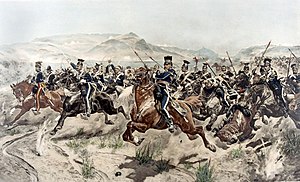Charge of the Heavy Brigade
| Battle of Balaclava (Balaklava) | |||||||
|---|---|---|---|---|---|---|---|
| Part of the Crimean War | |||||||
 Charge of the Light Brigade by Richard Caton Woodville, Jr. |
|||||||
|
|||||||
| Belligerents | |||||||
|
|
|
||||||
| Commanders and leaders | |||||||
|
|
|
||||||
| Strength | |||||||
| 20,000 British, 41 guns 7,000 French 1,000 Turkish |
25,000 78 guns |
||||||
| Casualties and losses | |||||||
| 615 | 627 | ||||||
The Battle of Balaclava, fought on 25 October 1854 during the Crimean War, was part of Siege of Sevastopol (1854–1855) to capture the port and fortress of Sevastopol, Russia's principal naval base on the Black Sea. The engagement followed the earlier Allied victory in September at the Battle of the Alma, where the Russian General Menshikov had positioned his army in an attempt to stop the Allies progressing south towards their strategic goal. Alma was the first major encounter fought in the Crimea since the Allied landings at Kalamita Bay on 14 September, and was a clear battlefield success; but a tardy pursuit by the Allies failed to gain a decisive victory, allowing the Russians to regroup, recover and prepare their defence.
The Russians split their forces. Defending within the allied siege lines was primarily the Navy manning the considerable static defenses of the city and threatening the allies from without was the mobile Army under General Menshiikov.
The Allies decided against an immediate assault on Sevastopol and instead prepared for a protracted siege. The British, under the command of Lord Raglan, and the French, under Canrobert, positioned their troops to the south of the port on the Chersonese Peninsula: the French Army occupied Kamiesh on the west coast whilst the British moved to the southern port of Balaclava. However, this position committed the British to the defence of the right flank of the Allied siege operations, for which Raglan had insufficient troops. Taking advantage of this exposure, the Russian General Liprandi, with some 25,000 men, prepared to attack the defences in and around Balaclava, hoping to disrupt the supply chain between the British base and their siege lines.
...
Wikipedia
